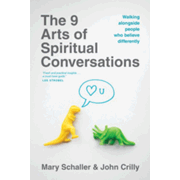I wasn't half way through The 9 Arts of Spiritual Conversation before I decided I needed to gather a group of people from our church to read and discuss this book together. Like many churches, our church has been exploring different ways to evangelize. We adopted the Alpha course last fall with amazing results thus far. A key component of the Alpha course is small group leaders who listen rather than teach. I am more and more convinced that listening is the most effective avenue to successful evangelism in our modern society, and the success of Alpha all around the world is testimony to that. People will not be convinced by logical arguments. They need to know that we care about them and are willing to listen to their thoughts and experiences without imposing our own.
Authors Mary Schaller and John Crilly share from their own experiences on a personal level as well as from working with Q Place, a non-profit that has developed a successful model for evangelism and discipleship through small groups. Through their work, the authors have developed nine “arts” for spiritual conversations. The nine arts are presented in three groups:
Arts for Getting Ready for spiritual conversations:
Noticing
Praying
Listening
Arts for Getting Started with spiritual conversations:
Asking Questions
Loving
Welcoming
Arts for Keeping it Going:
Facilitating
Serving Together
Sharing
(p. 28)
Chapters on each of these arts are the heart of this book. Two introductory chapters set the stage, and a final section describes the Q Place approach. Each chapter concludes with four questions or activities. Two “Discover” questions can be used either for discussion or personal reflection. Two “Practice” activities help us implement what we have just learned. For example, the first Practice activity for Chapter Five says, “Refrain from giving advice for a week. Then think about what it was like to listen and participate in a conversation without offering any suggestions about what others should do. What was their response?” (p. 95).
The book works on a number of levels. You can read it as a devotional, praying about your own approach to your conversations with others and praying specifically for others as you ponder the often challenging ideas presented here. You might read it to gain insights as to how to effectively evangelize in our modern culture. You might read it to learn how to use these conversational arts as a blueprint for your church’s evangelism efforts. Those struggling to form successful small groups might glean ideas, or you might decide to adopt the Q Place strategy. None of these purposes excludes the others.
In the discussion group that I have planned, we will read the book on our own—probably two or three chapters per week, ponder the questions and implement the activities, then get together to share our experiences and insights. Many of those planning to attend are involved with Alpha, small groups, or other evangelism activities where they will have opportunity to practice some of these conversational arts.
I see The 9 Arts of Spiritual Conversation as a perfect tool for anyone with a heart for evangelism, and particularly for those who want to have those conversations either in small groups or one-on-one. At our church, Alpha hosts have already been trained to some extent to be listeners rather than teachers. However, I think this book can take that training to a much deeper, much more productive level.









